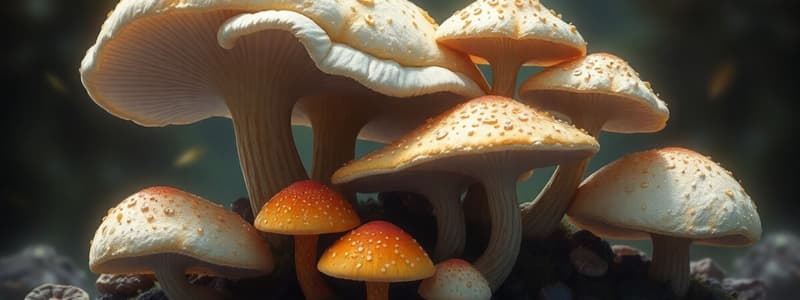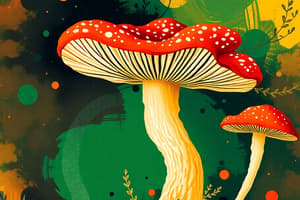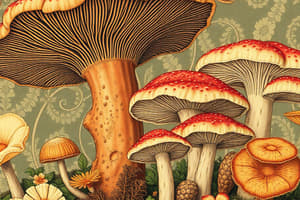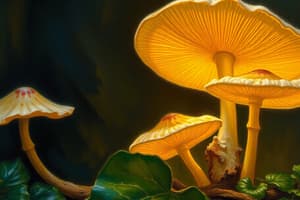Podcast
Questions and Answers
What is the kingdom to which fungi are assigned?
What is the kingdom to which fungi are assigned?
- Protista
- Animalia
- Mycota (correct)
- Plantae
Which type of mycosis is limited to the epidermis?
Which type of mycosis is limited to the epidermis?
- Opportunistic mycosis
- Systemic mycosis
- Subcutaneous mycosis
- Cutaneous mycosis (correct)
Which of the following characteristics differentiates fungi from plants?
Which of the following characteristics differentiates fungi from plants?
- Absence of chlorophyll (correct)
- Eukaryotic cellular structure
- Presence of chlorophyll
- Ability to reproduce sexually
What are the two basic morphologic forms of most fungi?
What are the two basic morphologic forms of most fungi?
Which of the following statements about fungal spores is correct?
Which of the following statements about fungal spores is correct?
What distinguishes true pathogenic mycoses from opportunistic mycoses?
What distinguishes true pathogenic mycoses from opportunistic mycoses?
What type of fungi can switch between filamentous and unicellular forms?
What type of fungi can switch between filamentous and unicellular forms?
What is one way fungi can cause harm to humans other than infection?
What is one way fungi can cause harm to humans other than infection?
What structure do hyphae form when they are densely packed?
What structure do hyphae form when they are densely packed?
Which characteristic distinguishes septate hyphae from nonseptate hyphae?
Which characteristic distinguishes septate hyphae from nonseptate hyphae?
What are 'true' pathogens responsible for systemic mycoses known to do?
What are 'true' pathogens responsible for systemic mycoses known to do?
Which of the following is NOT commonly considered an opportunistic mycosis?
Which of the following is NOT commonly considered an opportunistic mycosis?
What is a key feature of yeast-like fungi?
What is a key feature of yeast-like fungi?
In which of the following conditions do pathogenic dimorphic fungi appear yeast-like?
In which of the following conditions do pathogenic dimorphic fungi appear yeast-like?
What is the most commonly occurring fungal nosocomial pathogen?
What is the most commonly occurring fungal nosocomial pathogen?
Which group of fungi is responsible for cutaneous mycoses, also known as dermatophytoses?
Which group of fungi is responsible for cutaneous mycoses, also known as dermatophytoses?
What does oral candidiasis commonly present as?
What does oral candidiasis commonly present as?
Which of the following correctly describes systemic candidiasis?
Which of the following correctly describes systemic candidiasis?
What causes tinea versicolor, a superficial skin infection?
What causes tinea versicolor, a superficial skin infection?
Which factor has contributed significantly to the increase of immunocompromised individuals?
Which factor has contributed significantly to the increase of immunocompromised individuals?
What specific type of skin infection does tinea nigra represent?
What specific type of skin infection does tinea nigra represent?
Which of the following genera contain species that cause dermatophytoses?
Which of the following genera contain species that cause dermatophytoses?
Which population is most likely to develop opportunistic mycoses?
Which population is most likely to develop opportunistic mycoses?
Cryptococcosis is caused by which of the following organisms?
Cryptococcosis is caused by which of the following organisms?
What are the characteristic lesions of tinea corporis?
What are the characteristic lesions of tinea corporis?
Which statement is true regarding tinea pedis?
Which statement is true regarding tinea pedis?
In tinea capitis, what unique feature can be observed under UV light?
In tinea capitis, what unique feature can be observed under UV light?
What is the recommended duration of treatment for tinea unguium?
What is the recommended duration of treatment for tinea unguium?
Which of the following statements best describes subcutaneous mycoses?
Which of the following statements best describes subcutaneous mycoses?
What is one characteristic of sporotrichosis?
What is one characteristic of sporotrichosis?
Which organism is responsible for sporotrichosis?
Which organism is responsible for sporotrichosis?
Which condition is commonly known as jock itch?
Which condition is commonly known as jock itch?
Flashcards
Mycelium
Mycelium
A mass of branching, thread-like structures called hyphae that make up a fungus.
Hyphae
Hyphae
Filamentous cells that form the basic structure of a fungal mycelium.
Septate hyphae
Septate hyphae
Hyphae separated by cross walls or septa.
Nonseptate hyphae
Nonseptate hyphae
Signup and view all the flashcards
Yeast-like fungi
Yeast-like fungi
Signup and view all the flashcards
Dimorphic fungi
Dimorphic fungi
Signup and view all the flashcards
Cutaneous mycoses
Cutaneous mycoses
Signup and view all the flashcards
Tinea Versicolor
Tinea Versicolor
Signup and view all the flashcards
What are fungi?
What are fungi?
Signup and view all the flashcards
How are fungi classified?
How are fungi classified?
Signup and view all the flashcards
How many fungal species can cause human diseases?
How many fungal species can cause human diseases?
Signup and view all the flashcards
Explain the different types of fungal infections.
Explain the different types of fungal infections.
Signup and view all the flashcards
What are other ways fungi can affect humans?
What are other ways fungi can affect humans?
Signup and view all the flashcards
How are fungi different from other infectious organisms?
How are fungi different from other infectious organisms?
Signup and view all the flashcards
What are the two basic forms of fungi?
What are the two basic forms of fungi?
Signup and view all the flashcards
Describe the structure of mold-like fungi.
Describe the structure of mold-like fungi.
Signup and view all the flashcards
Tinea corporis
Tinea corporis
Signup and view all the flashcards
Tinea pedis
Tinea pedis
Signup and view all the flashcards
Tinea capitis
Tinea capitis
Signup and view all the flashcards
Tinea cruris
Tinea cruris
Signup and view all the flashcards
Tinea unguium
Tinea unguium
Signup and view all the flashcards
Sporotrichosis
Sporotrichosis
Signup and view all the flashcards
Chromomycosis
Chromomycosis
Signup and view all the flashcards
Opportunistic Mycoses
Opportunistic Mycoses
Signup and view all the flashcards
Nosocomial Infections
Nosocomial Infections
Signup and view all the flashcards
Candidiasis
Candidiasis
Signup and view all the flashcards
Oral Candidiasis (Thrush)
Oral Candidiasis (Thrush)
Signup and view all the flashcards
Vaginal Candidiasis
Vaginal Candidiasis
Signup and view all the flashcards
Systemic Candidiasis
Systemic Candidiasis
Signup and view all the flashcards
Cryptococcosis
Cryptococcosis
Signup and view all the flashcards
Disseminated Cryptococcosis
Disseminated Cryptococcosis
Signup and view all the flashcards
Study Notes
Medical Important Fungi
- Fungi are a diverse group of organisms, deriving nourishment from dead organic matter or being parasitic eukaryotic organisms.
- Fungal diseases are categorized based on location of infection.
- Cutaneous mycoses are infections limited to the epidermis, subcutaneous when they penetrate the skin, and systemic when deeply within the body.
- Mycoses can be further divided into true pathogenic and opportunistic fungi.
- Fungi can be unicellular or multicellular
- Fungi can be aerobic, or facultatively anaerobic, chemoheterotrophic organisms.
Structure and Classification of Fungi
- Fungi can be seen with naked eye or microscopically.
- Some fungi like mushrooms can be poisonous.
- Molds and yeasts can cause diseases and allergies.
Overview
- Although fungi were previously classified with plants, they are now categorized in their own kingdom- Mycota
- They can live aerobically or facultatively anaerobically.
- They are chemoheterotrophic, consuming organic matter for nourishment.
- Only about 100 of an estimated 200,000 fungal species are pathogenic to humans.
- Few fungal species are responsible for most clinically important fungal infections.
Mycoses
- Human fungal disease are classified by their location within the body.
- Cutaneous mycoses occur in the skin, hair, and nails
- Subcutaneous mycoses infect beneath the skin
- Systemic mycoses disseminate to internal organs.
- Systemic mycoses can be divided into true pathogenic, and opportunistic varieties.
Fungal Growth and Anatomy
- Fungi reproduce sexually, and asexually.
- Fungi can exist in filamentous (molds) and unicellular (yeasts) forms, or dimorphic forms.
- The filamentous form of fungi, called mycelium is composed of threads called hyphae.
- Hyphae can be interrupted by crosswalls (septate) or uninterrupted (coenocytic).
- Densely packed hyphae create a tissue like structure, often seen in mushroom bodies.
Yeast-like Fungi
- Yeast-like fungi are populations of single disconnected, spheroid cells similar to some bacteria.
- Some are 10 times larger than typical bacterial cells
- Reproduction commonly occurs via budding
- Unicellular fungi reproduce symmetrically via fission.
- Budding yeasts divide asymmetrically.
Dimorphic Fungi
- Some fungi can exist as either yeast (unicellular/budding) and mold (multicellular/filamentous) forms depending on environmental conditions, such as temperature or carbon dioxide levels.
- Examples include diseases like Blastomyces dermatiditis and Histoplasma capsulatum
Fungal Life Cycle
- Fungi reproduce sexually and asexually.
- Asexual reproduction involves spores, or conidia, produced on hyphae.
- Sexual reproduction occurs through processes like meiosis and karyogamy where cells fuse to form new genetic combinations.
Cutaneous Mycoses
- Cutaneous mycoses are caused by dermatophytes (fungi)
- Dermatophytes are grouped into three genera: Trichophyton, Epidermophyton, and Microsporum, each of which have many species.
- Some infections are classified based on infected area:
- Tinea versicolor (pityriasis versicolor)
- Tinea nigra
- Tinea pedis (athlete's foot)
- Tinea corporis (ringworm)
- Tinea capitis (scalp ringworm)
- Tinea cruris ("jock itch")
- Tinea unguium (onychomycosis)
Subcutaneous Mycoses
- Subcutaneous mycoses are fungal infections of the dermis, subcutaneous tissue, and bone
- Causative organisms reside in soil or decaying vegetation.
- Examples: Sporotrichosis, Chromomycosis, Mycetoma
General Properties of Subcutaneous Mycoses
- Usually acquired through traumatic lacerations, punctures, or thorn pricks.
- Increased prevalence in individuals with frequent contact with soil or vegetation.
Sporotrichosis, Chromomycosis, Mycetoma
- Description of the specific characteristics and symptoms of each infection.
Systemic Mycoses
- Organisms are categorized into true pathogens and opportunistic pathogens.
- Most common examples are coccidioidomycosis, histoplasmosis, and blastomycosis.
- These infections occur in defined geographic regions.
Opportunistic Mycoses
- These infections affect debilitated or immunocompromised patients.
- Immuno-suppressive treatments may increase the risk for opportunistic fungal infections,
- Common opportunistic fungal species are Candida species, Cryptococcus neoformans, Aspergillus, and Pneumocystis jiroveci.
Candidiasis (Candidosis)
- Caused by the yeast Candida albicans and other species.
- Common in mucous membranes, including the mouth, skin, vagina and intestines.
- Demonstrates dimorphism, capable of forming a true mycelium.
Cryptococcosis
- Caused by the yeast Cryptococcus neoformans
- Often found in soil with bird dropping.
- Common complication is meningitis
Aspergillosis
- Caused by the species Aspergillus fumigatus
- Primarily affects immunocompromised patients
- Can infect the lungs.
Pneumocystis jiroveci
- Caused by the yeast-like fungus Pneumocystis jiroveci.
- A type of pneumonia.
Nosocomial Infections
- Fungal nosocomial infections are approximately 15% of all hospital acquired infections, and are common in intensive care units.
- Frequently encountered opportunistic species include Candida species.
References
- Citations for text-based reference sources.
Studying That Suits You
Use AI to generate personalized quizzes and flashcards to suit your learning preferences.




